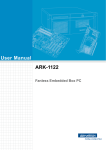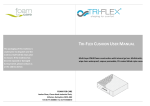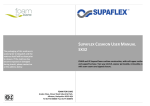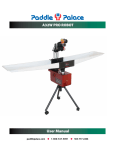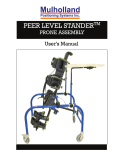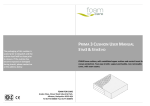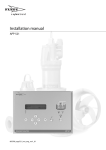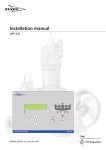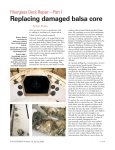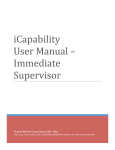Download MadStad RoboBracket Manual - Happy
Transcript
MadStad RoboBrackets Adjustable Windshield Mount (Patent Pending) ™ What is in the box: (1) Set of preassembled RoboBracket adjustable windshield mounts (4) M6 x 12mm mounting screws (4) M6 flat washers (4) M6 lock nuts (1) 4mm Allen wrench (hex key) (1) 10mm open-end wrench (4) M5 T-Screws (8) Rubber washers Extra Hardware: (4) Plastic spacers (4) M6 x 20mm mounting screws (1) Extra rubber washers User Manual MadStad RoboBrackets are designed to bolt down to your stock windshield or dashboard via the mounting tabs on the bottom brackets. A new windshield attaches to the top brackets using the rubber well nuts, washers and T-screws to hold it in place. The upper and lower brackets are connected via moveable link arms which allow you to adjust the windshield for height, tilt and distance from the rider. By loosening the adjustment screws you can slide and position the link arms in many different ways. Here are some side views showing how this works: Installation: Your RoboBrackets must be attached to the base shield as shown in the diagram at right. The mounting tabs on the brackets go to the outsides of the mounting base, meaning that they point outward to the left and right, not inward toward each other. (See example on Page 5.) The thin rubber washers are used as a cushion between the metal and plastic. The same goes for the sealing washers underneath the windshield with the rubber side pressing against the plastic. DO NOT OVERTIGHTEN THE MOUNTING SCREWS! You only need to snug this assembly together to hold it solidly in place. If you over tighten the screws and nuts you could crack the plastic base. In some cases your base shield will be too rounded for the brackets to sit flat against the plastic. In that case use the thick rubber washers between the brackets and base. They will lift the brackets up enough to clear the curvature of the plastic. Once your brackets are bolted to the base, attach your windshield to the brackets using the T-screws and rubber washers as shown at right. They are inserted into the four rubber well nuts in the top of the RoboBrackets. DO NOT OVERTIGHTEN THE T-SCREWS! The rubber well nuts cannot be pulled up out of the brackets, even if they are not tight, so tighten only until the well nuts begin to swell up and the shield is snug against the brackets. Installation: Do-It-Yourself From Scratch If you received just a set of brackets with hardware and you are going to experiment with your own custom installation, first read this disclaimer: IMPORTANT: MadStad Engineering is not responsible for any modifications you make to your windshields or motorcycle. Some of the changes and modifications discussed in this manual are permanent, and MadStad Engineering shall not be held liable for the cost or replacement of any motorcycle parts or accessories that are modified. In other words, if you cut it or drill it and it doesn’t work out, that is your responsibility. Base Shield Preparation The MadStad RoboBrackets must be mounted to a base, often the stock windshield on your bike. If your stock shield is thin and flimsy it will not make a good base, and we recommend that you contact us for a stronger shield. If you feel your base shield is sturdy, consider shortening it to make it stronger. Here is an illustration: Although the RoboBrackets are designed to be mounted up at the top edge of the base shield, you can mount them anywhere you want without cutting the shield. On the Triumph Tiger example at right, if we mounted the brackets at the top of the stock shield, air pressure would cause the top of that shield to bend and flex. However, if we cut the shield down about 75-100 mm (3-4 inches), it would bring the brackets down closer to the fairing where the shield is better supported, making it stronger and less likely to flex from air pressure. If you are not comfortable with or able to cut down your shield, you could simply mount the RoboBrackets lower down on the base shield as-is, at or below the cutoff line. While this will work, it will also somewhat restrict your rearward adjustment options. To cut down the shield you can use a fine-tooth band saw, sabre saw, hack saw or coping saw to make the cut. Use removable masking tape (painter’s tape) to protect the front surface of the shield where it will make contact with your saw. Place the tape across the line where you want to cut, then mark the line on the tape using marker or pencil, duplicating original top line of your shield. Do not cut the shield too short or you will not have room to attach the brackets. Set the brackets on the shield to make sure you have enough vertical space for the base mounting holes. The brackets should also be separated by at least 130 mm (5 inches) of space between them. If you space them too closely together they will not support the windshield properly. As a general rule, wider is better. Mounting Hole Drilling To mount the brackets you will need to drill holes in plastic. Although there are special drill bits available for this, they are not necessary. If you have them, use them as they will give you a nice clean hole. If using standard wood/metal drill bits, make sure they are sharp and do not apply heavy pressure or you may crack your shield. You will need a 6 mm (1/4”) drill bit for the base holes, and an 8mm (5/16”) drill bit for the top shield holes. Base Holes Before you drill the base holes, find the centerline of the windshield so that your brackets are spaced evenly: 1. Run a length of painter’s tape down the approximate center of the windshield. 2. Take a piece of paper and lay it across the surface of the shield, with the long edge going from the upper left factory mounting hole to the upper right. Take a pencil and mark a line on the paper’s edge at the center of each hole. If factory screw holes are not available use another similar reference point that is the same on both sides of the shield. 3. Fold the paper over matching up the two marks, and then crease it together evenly. When you unfold it, the crease will be your centerline. 4. Lay the paper back over the windshield and align your two pencil marks back on the same two factory screw holes or reference points. Use the pencil to mark the centerline on the painter’s tape down the center of the shield. Base Bracket Alignment (Front View) Once you have found the centerline you can measure outward to evenly space your brackets. We recommend a separation of 130-200 mm (5-8”) but this could vary a bit depending upon your windshield. Generally speaking wider is better, but you also want to make sure that your top shield will fit on this spacing as well. NOTE: We recommend that you first mark and drill only the top holes first. Windshield curvatures can distort parallel lines so it would be better to set the actual brackets parallel to each other using the top mounting holes. Then afterward you can mark the bottoms accordingly. Once the holes are drilled, bolt the brackets in and check if they are parallel. If they are off just a little bit it is not a problem. You can always drill the base holes another size larger to give yourself some extra “wiggle room” to align the brackets. A Note Regarding the Mounting Tabs The mounting tabs are bent at approximately a 70 degree angle. For most windshield curvatures, this will set the brackets in an upright (90 degree) position once they are bolted on. However, if you find that the brackets seem to be angled too much inward or outward, it may be necessary to bend the tabs a bit. This is not very easy with 14 gauge stainless steel, so if you do not have the appropriate tools and expertise available, please contact MadStad Engineering for further instructions. In addition, your base shield may have a bit of a vertical curvature that prevents the straight brackets from laying flat. You can remedy this by shimming up the top mounting tabs with a rubber washer as a spacer. Two extra washers have been provided for this purpose, as well as two slightly longer M6 x 16mm screws. Windshield Holes Once the brackets are bolted down, fold and set them so the windshield mounting well nuts are directly across from each other, like this: Lay the top windshield over the brackets and center it up as best you can. (If you need to, mark a centerline as you did for the base shield.) The windshield holes should be in the bottom 1/3 of the windshield, but leave at least 1-1/2” (35mm) of space from the bottom, and drill no closer than 1” (25mm) to any outer edge of the shield. Once the shield is aligned to your satisfaction, use a marker to mark each hole location over the four well nuts, then drill the 5/16” (8mm) holes. Adjusting the RoboBrackets The four screws connecting the link arms to the bottom brackets are the main points of adjustment. These screws provide both the sliding (height) and link arm pivot adjustment. The top four screws connecting the link arms to the top brackets must be loosened slightly to allow the link arms to pivot. If they are fully tightened then you will only be able to adjust the height of your windshield. NOTE: Two wrenches have been provided for bracket adjustment. If the brackets are collapsed to the point where you cannot get your hands underneath to make the adjustments, you will need to remove the windshield first. This is an easy procedure as the four T-screws holding the windshield on come off quickly and without tools. Step 1 - Loosen all four bottom screws using the tools provided. It is not necessary to loosen each screw completely, just enough to allow them to slide back and forth. Step 2 – Move the link arms to position your windshield at the desired height, depth and angle. The top four screws should be snug enough to hold the brackets in position, yet just loose enough to rotate. Be aware that the link arms will not pivot unless the bottom screws are at the very end of the link arm slot. If you have removed the windshield, position both sides in parallel, at the same angle. Step 3 – Tighten all four bottom screws and all four top screws for maximum holding strength. Re-attach the windshield if it was removed for the adjustment. Use the rubber washers for cushioning above and below the windshield mounting holes. You may have to take several test rides to find an ideal windshield position and angle. There are many factors that affect airflow including your height and riding position. Start your adjustable shield out in a lower position rather than higher as you will likely discover that you don’t need a tall windshield to get great airflow and wind protection. THE LATEST USER MANUAL CAN BE DOWNLOADED AT http://www.robobrackets.com Disclaimer Neither MadStad Engineering nor its owners shall be liable for any damages, consequential or inconsequential, resulting from the use of our products. Installation of any of our products constitutes acceptance of these terms. It is the responsibility of the user to make sure all fasteners are tightened securely, the windshield mounted properly and the adjusters tightened snugly before putting the motorcycle in motion. The MadStad mount IS NOT intended to be adjusted while the motorcycle is in motion; you must pull over out of the way of traffic and come to a complete stop before making any adjustments. The user must never place the windshield in such a position as to interfere with the safe and complete movement of the handlebars. We welcome all comments and suggestions! MadStad Engineering 5312 Azalea Circle, Ridge Manor, FL 33523 U.S.A. Phone: 352-608-4069 Fax: 352-608-4195 Web Site: http://www.madstad.com Email: [email protected] Thank you for your support, and ride safely! ™








